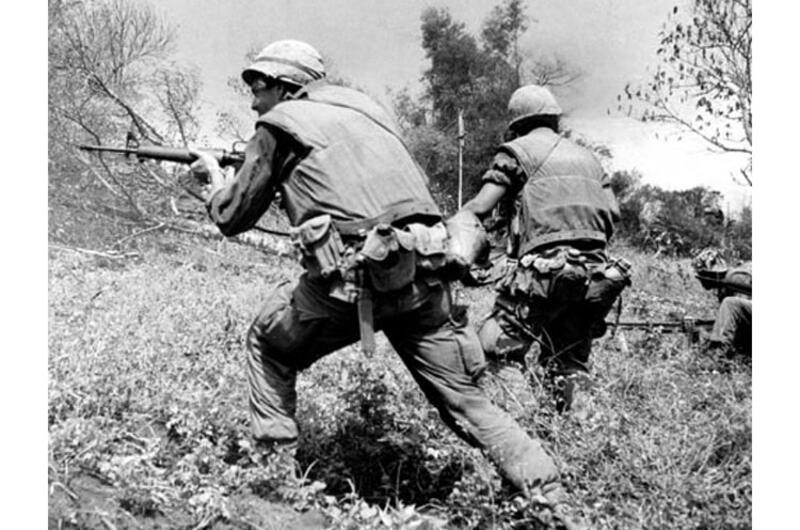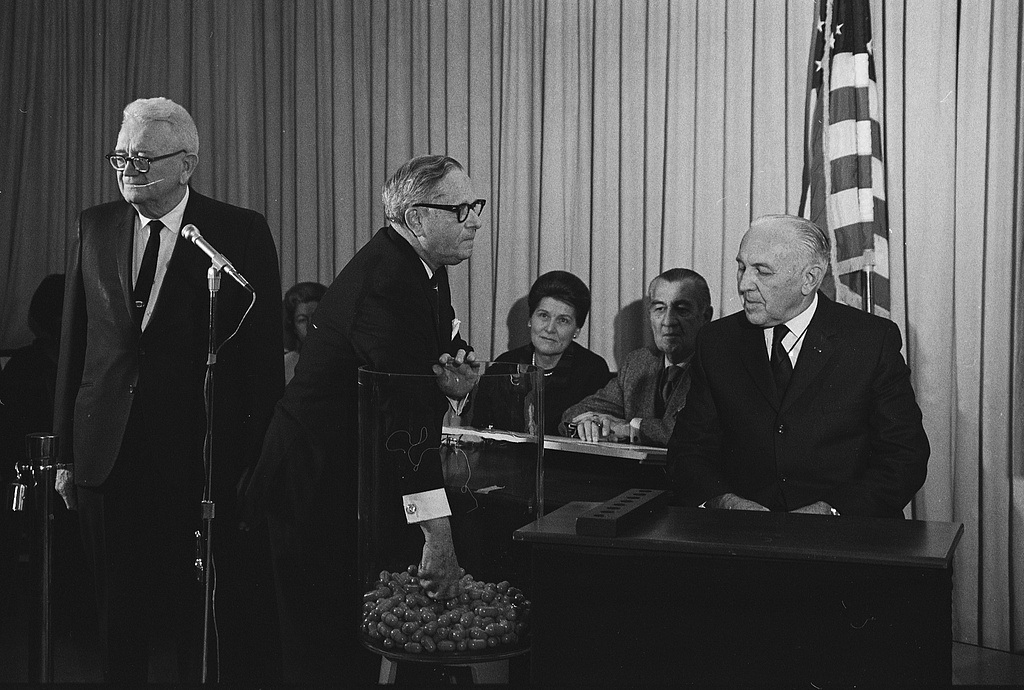Vietnam leads to the death of the draft and the rise of the professional soldier

South Vietnam, May, 1967: U.S. Marines fire as they charge against a North Vietnamese position near Con Thien during Operation Prairie IV.
By John Vandiver | Stars and Stripes November 11, 2014
During the dark days of Vietnam, morale was so low hit lists were known to circulate within units, nominating unpopular leaders to be fragged — the military term when soldiers murder one of their own.
“Don’t desert. Go to Vietnam and kill your commanding officer,” wrote one underground GI newspaper during the height of the war.
At the time, there were close to 150 underground newspapers circulating in the war zone and at bases at home, in which troops vented about the state of war, urged dissent and even in some cases the murder of leaders. As the war grew in unpopularity, inside and outside of the military, so did the idea of maintaining an Army that in large measure relied on filling the ranks with soldiers conscripted against their will.
“The Vietnam war was absolutely the mother of the volunteer force. The country was not only war weary, it was draft weary,” said Bernard Rostker, a former top Pentagon manpower official and author of “I Want You! The Evolution of the All-Volunteer Force.”
But while Vietnam was a low point, it also served as the engine of change that brought about perhaps the single greatest reform to transform the military in the post-Vietnam war era: the launch of the all-volunteer force. Its legacy is the warrior class of today, the 1.3 million-strong active-duty service that is just a fraction of the roughly 140 million Americans eligible to serve.
During the Vietnam-era, there were tens of thousands of desertions and widespread drug use within the garrisons at home and abroad. To be sure, many served with great honor and valor during Vietnam, but the consensus at the time was that order and discipline had never been worse.
Indeed, Vietnam, where 648,500 draftees were sent to fight and 17,725 died in combat, exposed the pitfalls of fighting an unpopular war with conscripted soldiers. There also was growing concern about the fairness of a system that resulted in a disproportionate number of poor Americans being drafted.
For instance, in 1970 the Army alone had more than 65,000 deserters, just one sign of a military reaching the breaking point. The combined effects of low morale, undisciplined troops and questions about fairness of the draft system proved to be the death knell of the conscripted force.
Marine military historian Col. Robert d. Heinl, Jr., writing in the 1971 edition of the Armed Forces Journal , captured the mood at the time.
“The morale, discipline and battle worthiness of the U.S. Armed Forces are, with a few salient exceptions, lower and worse than at any time in this century and possibly in the history of the United States,” Heinl wrote.
“By every conceivable indicator, our army that now remains in Vietnam is in a state approaching collapse, with individual units avoiding or having refused combat, murdering their officers and non- commissioned officers, drug-ridden, and dispirited where not near mutinous,” Heinl stated.
However, the road to today’s professional force was bumpy at times, requiring about a decade to fully take shape after the last draft notices were issued in late 1972.
The move toward the all-volunteer force began in earnest in 1968, when presidential candidate Richard Nixon made the idea part of his official platform. Upon taking office, Nixon then created the Gates Commission in 1969 which examined the logistics of making the switch to a volunteer service. After several years of working out the details in Congress and within the Pentagon, the draft ended for good in 1973.
But if low morale and too many disgruntled troops in the ranks were part of what pushed political leaders to move away from the draft in the first place, the early days of the volunteer force didn’t bring about immediate order and discipline.
“The quality of the soldiers was not very good, largely because the Army had to learn how to recruit,” Rostker said. “The Army thought they were bringing in qualified people and they weren’t. It doesn’t sort itself out until 1979 and 1980.”
Over the objections of President Jimmy Carter, senators Sam Nunn, D-Ga., and John Warner, R-Va., leading proponents of the volunteer force, pushed legislation that would give significant salary increases to troops, something President Ronald Regan backed upon taking office. Previous raises hadn’t been enough to attract enough quality recruits, Rostker said.
Throughout the 1980s the force steadily improved as new Army institutions such as the National Training Center at Fort Irwin took shape.
“I think the revolution in tactics and training that came later by general officers who served in Vietnam is also very much tied to the volunteer force,” said Rostker, who now serves as an analyst with the RAND corporation in Washington. “It would all fall on deaf ears if we had a high turnover conscription force and not a professional force. The linchpin to today’s professional force is the stability of the all-volunteer force.”
Then in 1990, Saddam Hussein invaded Kuwait and troops headed to the Persian Gulf for their first major test.
“In the first Gulf War, that’s when the all-volunteer force proved itself,” said Rostker, who served as the Pentagon’s undersecretary of personnel and readiness in 2000-2001.
Proponents of the volunteer service say ending the draft also contributed to establishing a force more representative of the nation as a whole. In 1973, only 2 percent of enlisted members were women, compared to about 15 percent today. During Vietnam, a major flaw of the draft was that the poor and minorities served at disproportionate rates to middle class white America. At the end of the draft, 28 percent of enlisted personnel were black, who were just 11 percent of the population at the time. That number is down to about 16 percent today, which is more in line with today’s general population of 13 percent.
Advocates for the draft, however, still emerge from time to time.
During the height of the Iraq War, some began to question whether a military of volunteers resulted in a population disconnected from the wars that were being waged. There also were serious concerns about the burden being carried by a fighting force of volunteers, many of whom carried out multiple deployments.
Some politicians, such as Rep. Charles Rangel, D-N.Y., have made attempts in recent years to bring back the draft, but those efforts have gone nowhere. Even some military leaders, concerned about the American public’ disconnect from the military that fights its wars, have flirted with the idea of a return to the draft.
Retired Gen. Stanley McChrystal favors the idea.
“I now believe we need a draft. America's defense should be performed by a representative cross section of the population,” the retired general said in 2013 interview with Foreign Affairs magazine.
But Rostker, who also served as director of the U.S. Selective Service System form 1979-1980, says there would be little to be gained in returning to some form of the draft.
With roughly 4 million Americans each year reaching draft age, supply far exceeds demand, he said. The Army, for example, only takes in about 50,000 soldiers each year, which means few would ever see boot camp let alone generate a cultural reconnection with the military.
“The problem is the conditions that caused the initial problems with the draft have not changed, and they are the Army’s need for manpower is very small compared to the U.S. population,” Rostker said. “The question is, who serves when not all can serve?"
Now, however, the debate is essentially settled over the all-volunteer force with no serious consideration given to a return to conscription.
Still, even the early implementers of the volunteer service never imagined that long ground wars could be fought without a return to the draft, something today’s servicemembers have just now achieved after more than a decade of fighting in Iraq and Afghanistan.
“The big shock of the all-volunteer force was that we could go to war and not return to the draft. We knew we could deploy once, but not two, three four, five times,” Rostker said.“We’ve created a warrior class of which going to war, going to deployment, is the norm.”
Yet the all-volunteer service comes with a cost, both in terms of dollars — a 15-year soldier costs considerably more than a two year draftee — and the physical toll on those who deploy again and again.
“It’s cost us socially,” Rostker said. “It’s cost us in terms of families. It’s cost us in PTSD because the research suggests the psychiatric effects of war are cumulative effect. It’s expensive. Having said all of that, it is a remarkable, remarkable force. And we’ve paid for it.”

MARION S. TRIKOSKO/LIBRARY OF CONGRESS



